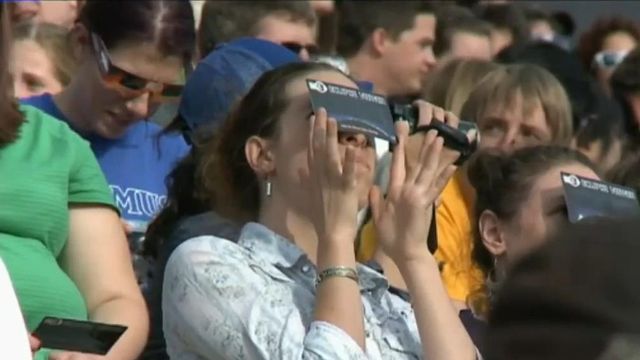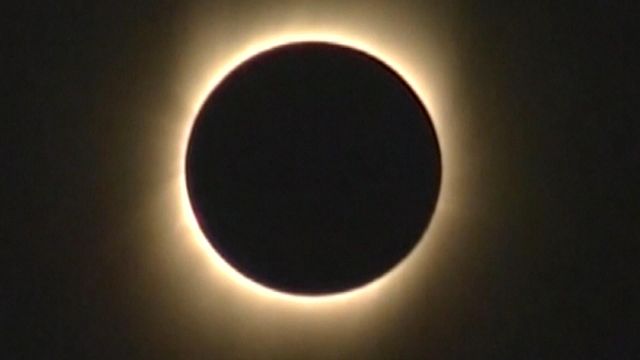2024 total eclipse: Where, when and what we'll see in North Carolina
A total solar eclipse, one of nature's most spectacular sights, is coming to North America on April 8.
Weather permitting, it will be visible on a path from Mexico through Texas, Oklahoma, Arkansas, Missouri, Illinois, Kentucky, Indiana, Ohio, Pennsylvania, New York, Vermont, New Hampshire and Maine before venturing into eastern Canada.
For many Americans, the event will be one of the biggest astronomical phenomena since the August 2017 total eclipse.
In October of 2023, there was an annular solar eclipse where the path extended over the northwest and southwest U.S.
The eclipse coming in April 2024 will make for a compelling sight that reveals the Sun's corona in an unusually darkened sky.
"I've been talking about this one for years," said NASA Ambassador Tony Rice. "It's going to be the highlight of the year."
What makes 2024 eclipse so special?

In an annular eclipse, the moon covers the sun, but never reaches 100 percent totality. The outer edge still shines during an annular eclipse, which creates a neat effect referred to as "the ring of fire."
During a total eclipse, the moon completely covers the sun. The corona is only visible at 100 percent obscuration, which is only possible inside the path of totality.
The inner black circle, called the umbra, is where the shadow is complete and an eclipse of the sun is total. The effect gives the sky an eerie quality.
In the U.S., the path of totality of the April 8 eclipse extends from the south to the midwest and continues into the northeast and New England regions.
In the pantheon of eclipses, this one ranks as one of the more significant eclipse events. The extent of totality will be as long as four minutes, 27 seconds – almost twice as long as the 2017 eclipse, which was seen by about 20 million people in the path of totality.

The August 2017 event passed through the country from Oregon to South Carolina, but the path of totality didn't include many population centers outside of Kansas City and St. Louis. The path of the 2024 eclipse includes several major cities; approximately 31 million people live in the path of totality.
What will the eclipse look like in North Carolina?
The eclipse won't be quite as spectacular for us in the Triangle as we aren't in the path of totality. We will see a partial eclipse. For point of reference, around 78 percent of the sun will be obscured at WRAL Studios on Western Boulevard in Raleigh, so most in the Triangle can expect a similar experience.
Since North Carolina is a state that runs about 560 miles east-to-west, there's a wide variance of outcomes for the eclipse. Western North Carolina will see a more obscured sun as Murphy will be at 86 percent obscuration. Meanwhile, Rodanthe, along the Outer Banks, will be at 72 percent obscuration.
The eclipse will first be visible in Mexico and Texas, then along a line north and east into Canada in Southern Ontario and through Quebec, New Brunswick, Prince Edward Island and Cape Breton.
The eclipse then goes into Canada in Southern Ontario and continues through Quebec, New Brunswick, Prince Edward Island and Cape Breton.

Here are some other common questions and facts about this eclipse.
When does the 2024 eclipse begin?: In the U.S., totality will begin in Texas at 1:27 pm CDT and will end in Maine at 3:35 pm EDT. The first location in continental North America that will experience totality is Mexico’s Pacific coast at around 11:07 a.m. PDT.
How big is the path of totality?: The path of totality is up to 123 miles wide as it moves northeast from Mexico to eastern Canada.
What US cities will see the 2024 eclipse?: San Antonio, Dallas, Austin, Indianapolis, Cleveland, Buffalo, Montreal
What will we see in Raleigh?: We'll only see a partial eclipse here, starting just before 2 p.m. We'll see the maximum effect at approximately 3:15 p.m. Unfortunately, totality will not be visible from North Carolina. The amount of the Sun covered by the Moon will vary from nearly 86% near Boone to just over 70% in Wilmington. Around Raleigh around 78% of the Sun will be eclipsed by the Moon.
How can I look at the eclipse safely?: The most important rule to remember here is to use ISO-certified-safe solar glasses and viewers. Regular sunglasses are NOT safe for viewing. You can purchase the appropriate glasses and viewers here. Other viewing methods such as pinhole projectors are also suitable. You'll want to secure these before they sell out.
Where will it make landfall in North America?: The moon's shadow first touches Mexico at Mazatlan and the path extends northeast through Mexico, the U.S. and Canada. The longest duration of totality will be near Torreon, Mexico, at 4 minutes and 27 seconds.
When's the next total solar eclipse?: The next total solar eclipse that will be viewable from the contiguous U.S. will be Aug. 23, 2044.
When will North Carolina be in the path of totality for a total eclipse? The next total eclipse with the path of totality in North Carolina will be May 11, 2078. Here's a look at that pathway.

Wake up!: When a solar eclipse reaches totality, nocturnal wildlife are sometimes confused into believing it's night, waking up.
Other sites with eclipse resources and info
NASA overview of the 2024 Total Eclipse: Where & When
NASA: Eclipse safety guidelines












